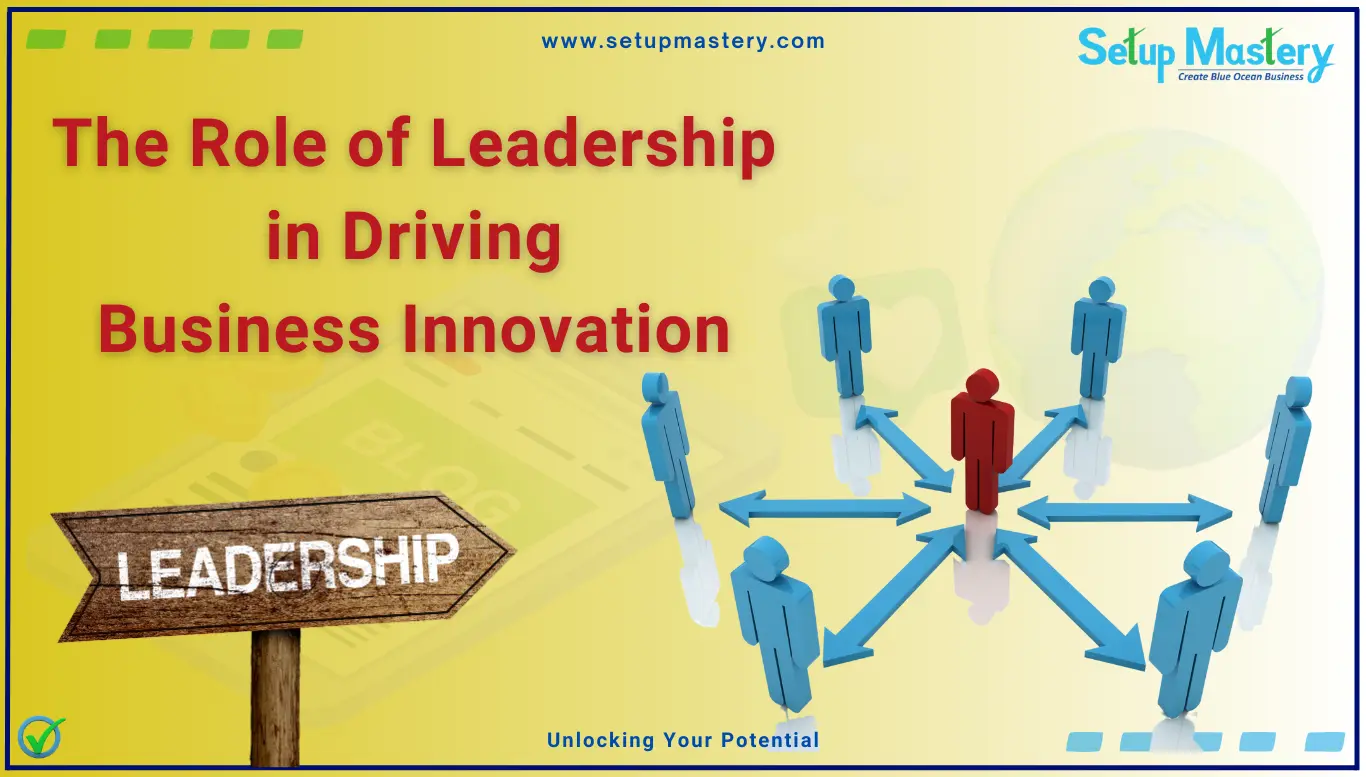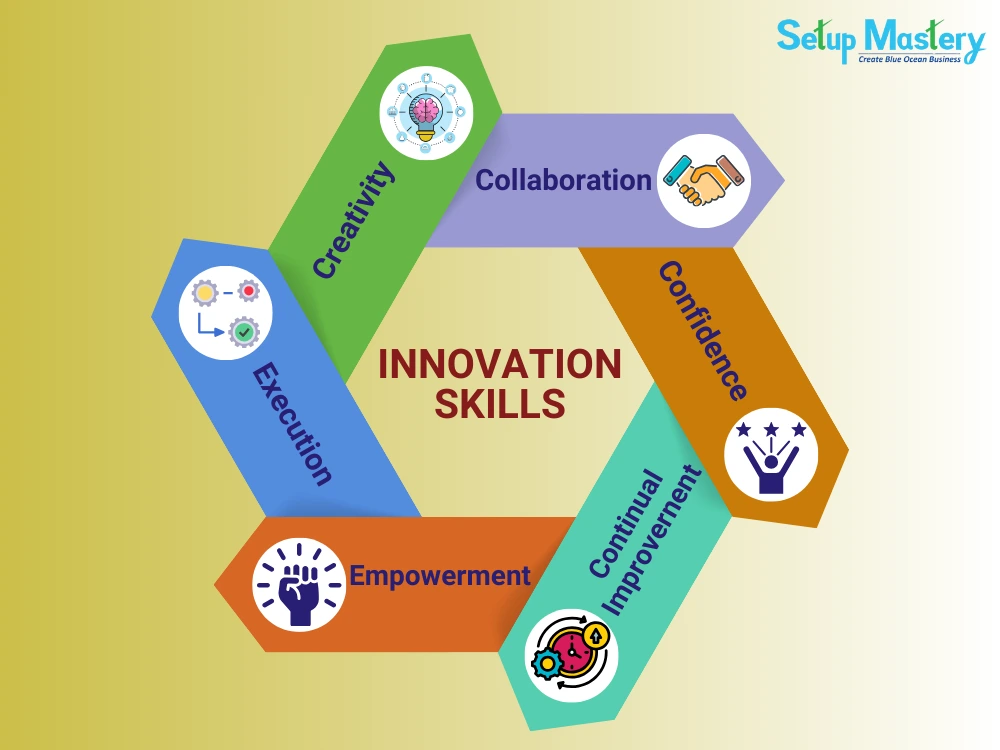The Role of Leadership in Driving Business Innovation

Descriptions
Additionally, the ability to navigate organizational change management is crucial for ensuring these innovations are successfully implemented and embraced across the organization.
Did You Know?
- Visionaries:
They Articulate a clear and compelling vision of what the organization aims to achieve through innovation in business. This vision serves as a guidepost for teams, ensuring everyone is aligned, motivated, and inspired to exceed expectations. - Facilitators:
By Providing DEssential Resources, advanced tools, and a conducive work environment, leaders remove obstacles that hinder innovation and ensure teams have the confidence and support to experiment. - Mentors:
They Guide teams in Exploring New Ideas, offering constructive feedback while encouraging them to learn from failures a natural and valuable part of the innovation process that fosters resilience and growth. - A compelling vision instills purpose, aligning efforts and creating a sense of direction.
- Leaders must communicate this vision consistently across all levels, ensuring every employee understands their role in achieving it.
- For example, a leader might set a vision for becoming a market leader in sustainability by innovating eco-friendly products, inspiring employees to contribute their ideas toward this goal, thus creating a unified and committed workforce.
- Empowered employees are more confident, engaged, and innovative, driving the organization forward.
- By providing resources, training, and decision-making power, leaders ensure that their teams are equipped to tackle complex challenges.
- Leaders should also create opportunities for professional growth, allowing employees to develop new skills and take on greater responsibilities, which in turn fuels innovation in business.
- Effective organizational change management ensures that teams remain agile and responsive to market shifts.
- Leaders must anticipate changes, prepare their teams, and continuously adapt strategies to stay competitive.
- They should also foster a culture of flexibility, encouraging employees to be open to new approaches and technologies, thereby enhancing the organization's ability to innovate and thrive amidst change.
- Offering training programs, workshops, and access to industry knowledge keeps teams ahead of the curve.
- Leaders should promote knowledge sharing and collaboration, encouraging employees to learn from each other and stay informed about industry trends.
- For example, leaders in the tech industry often encourage employees to acquire certifications in emerging technologies to drive innovation, ensuring the organization remains at the forefront of technological advancements.
- Rewards can take many forms, from public recognition to financial incentives, fostering a sense of accomplishment and motivating continued innovation.
- This approach reinforces a culture of innovation in business, motivating employees to continue pushing boundaries and exploring new ideas.
- Regularly highlighting and rewarding creative solutions not only boosts morale but also encourages a competitive spirit that drives further innovation across the organization.
Change is often the precursor to innovation, as it creates opportunities for growth and reinvention. Businesses need leaders who not
only anticipate change but also inspire confidence and resilience among their teams, guiding them through complex transitions. Here,
we explore the indispensable role of successful leadership in fostering innovation in business, implementing change effectively, and
driving long-term organizational success while maintaining a competitive edge.
1.
Leadership as a Catalyst for Innovation
Successful leadership is the driving force behind any organization’s ability to innovate. Leaders act as enablers,
creating an environment where ideas can flourish, employees feel empowered to contribute their creativity, and the organization thrives
on a foundation of continuous improvement. Exceptional leadership and management prioritize communication and collaboration, breaking down
silos and barriers that stifle innovation while fostering trust and transparency across all levels of the organization.
In this context, leaders play several key roles:
Leaders who excel in these roles inspire their teams to embrace creativity and actively contribute to meaningful projects. For example, companies like Tesla and Apple are renowned for their culture of innovation in business, which stems directly from the visionary leadership and management of their founders. These leaders have not only mastered the art of turning creative concepts into groundbreaking products but have also established collaborative environments where every individual’s contributions are valued. By aligning teams with their vision and fostering a culture of openness, these organizations consistently push the boundaries of possibility.
2.
Building a Culture of Innovation
A thriving culture of innovation in business does not happen by accident. It is deliberately nurtured by leaders who understand the importance of empowering their workforce and fostering an environment where creativity and experimentation are celebrated. The role of leadership and management here is to establish an atmosphere of trust and openness where employees feel safe to express their ideas, even if those ideas involve risks. Leaders must actively promote transparency, provide consistent encouragement, and remove barriers that stifle collaboration to ensure innovation thrives across the organization.
1. Encouraging Risk-Taking and Learning
Innovation in business often requires taking calculated risks, as groundbreaking ideas rarely emerge from the comfort zone. Leaders who embody successful leadership inspire their teams to step into uncharted territories, embracing challenges with confidence. Importantly, they also foster an environment where failures are not seen as setbacks but as critical learning opportunities. By reframing failure as a stepping stone to improvement, leaders cultivate resilience and perseverance, key traits for sustaining innovation. This approach drives a mindset shift, where employees feel more confident to experiment and contribute.
2. Promoting Diversity and Inclusion
Leadership and management must prioritize building diverse teams that bring a wide range of perspectives and experiences to the table. Diversity sparks creativity by encouraging different approaches to problem-solving and fostering richer brainstorming sessions. Leaders who embrace and actively promote diversity create organizations that are not only adaptable but also better positioned to innovate in a competitive market.
For example, multinational organizations like Google and Microsoft emphasize the importance of diversity in driving innovation in business. These companies encourage employees from varied cultural, educational, and professional backgrounds to collaborate on projects, leveraging their unique perspectives to solve complex challenges. The result is a consistent stream of pioneering ideas, solutions, and industry-leading advancements. Furthermore, inclusion initiatives often enhance employee morale, ensuring everyone feels valued and invested in the organization’s success.
3.
The Intersection of Leadership and Organizational Change
One of the most critical roles of successful leadership in times of change is clear, transparent communication. Leaders must articulate why change is necessary, demonstrating how it aligns with the organization’s long-term goals and vision for innovation in business. Additionally, they need to clarify the specific roles employees will play in the process, empowering them to feel like active participants rather than passive recipients. Open and honest communication fosters trust, minimizes resistance, and ensures employees understand the bigger picture. Regular updates, town halls, and feedback sessions are powerful tools leaders can use to maintain transparency and engagement.
1. Communicating the Need for Change
Innovation in business often requires taking calculated risks, as groundbreaking ideas rarely emerge from the comfort zone. Leaders who embody successful leadership inspire their teams to step into uncharted territories, embracing challenges with confidence. Importantly, they also foster an environment where failures are not seen as setbacks but as critical learning opportunities. By reframing failure as a stepping stone to improvement, leaders cultivate resilience and perseverance, key traits for sustaining innovation. This approach drives a mindset shift, where employees feel more confident to experiment and contribute.
2. Leading with Empathy
Navigating organizational change management effectively requires leaders to lead with empathy and emotional intelligence. This means understanding the concerns, fears, and uncertainties that employees may face during times of transition. Leaders must provide reassurance, addressing these challenges with patience and support. Empathy helps employees feel valued, boosting morale and encouraging a smoother adaptation to change. Leaders can also foster connection by being accessible and approachable, actively listening to employee feedback, and tailoring their support based on individual needs.
For instance, during a digital transformation, leaders who focus on both the technical and emotional aspects of change are far more likely to succeed. They not only provide comprehensive training programs and access to resources but also create forums for employees to ask questions and express concerns. By offering consistent reassurance, addressing technical challenges promptly, and celebrating small victories along the way, such leaders help their teams embrace new technologies with confidence and optimism.

4.
Key Strategies for Leadership in Driving Business Innovation
Here are five critical strategies that highlight how leadership and management can foster innovation in business while ensuring smooth organizational change management:
1. Vision Setting
Leaders must paint a vivid picture of the future, showing how innovation in business will benefit the organization and its stakeholders. This vision acts as a rallying point, motivating teams to work toward a shared goal.
2. Empowering Teams
Empowerment is at the core of successful leadership. Leaders must delegate authority and encourage their teams to take ownership of their work.
3. Encouraging Continuous Learning
Adaptability is a hallmark of successful leadership. In a world where industries evolve rapidly, leaders must guide their organizations through constant transformation.
4. Adapting to Change
Innovation in business thrives in organizations where learning is a priority. Leaders must foster a culture of curiosity and lifelong learning.
5. Recognizing and Rewarding Creativity
Recognition is a powerful motivator. Leaders must celebrate the contributions of their teams, acknowledging both successes and innovative efforts.
Conclusion
The role of leadership and management in driving innovation in business cannot be overstated. Exceptional leaders inspire their teams,
create environments conducive to creativity, and guide organizations through change with confidence and empathy. They prioritize communication,
collaboration, and inclusivity, ensuring every team member feels valued and empowered to contribute innovative ideas. By mastering organizational
change management and fostering a culture of innovation, leaders pave the way for long-term success, building resilient organizations capable
of thriving in uncertain environments.
Ultimately, successful leadership is about more than achieving immediate results it’s about building a legacy of adaptability,
creativity, and growth. In a world where change is constant, effective leadership and management remain the cornerstone of innovation,
progress, and sustainable organizational growth.
January 20, 2025
